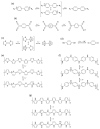Flexing the Spectrum: Advancements and Prospects of Flexible Electrochromic Materials
- PMID: 37447568
- PMCID: PMC10346273
- DOI: 10.3390/polym15132924
Flexing the Spectrum: Advancements and Prospects of Flexible Electrochromic Materials
Abstract
The application potential of flexible electrochromic materials for wearable devices, smart textiles, flexible displays, electronic paper, and implantable biomedical devices is enormous. These materials offer the advantages of conformability and mechanical robustness, making them highly desirable for these applications. In this review, we comprehensively examine the field of flexible electrochromic materials, covering topics such as synthesis methods, structure design, electrochromic mechanisms, and current applications. We also address the challenges associated with achieving flexibility in electrochromic materials and discuss strategies to overcome them. By shedding light on these challenges and proposing solutions, we aim to advance the development of flexible electrochromic materials. We also highlight recent advances in the field and present promising directions for future research. We intend to stimulate further innovation and development in this rapidly evolving field and encourage researchers to explore new opportunities and applications for flexible electrochromic materials. Through this review, readers can gain a comprehensive understanding of the synthesis, design, mechanisms, and applications of flexible electrochromic materials. It serves as a valuable resource for researchers and industry professionals looking to harness the potential of these materials for various technological applications.
Keywords: flexible electrochromic materials; hybrid-based electrochromic materials; inorganic-based electrochromic materials; organic-based electrochromic materials.
Conflict of interest statement
The authors declare no conflict of interest.
Figures










Similar articles
-
Organic Iono-Optoelectronics: From Electrochromics to Artificial Retina.Acc Chem Res. 2025 Jan 7;58(1):24-35. doi: 10.1021/acs.accounts.4c00512. Epub 2024 Dec 25. Acc Chem Res. 2025. PMID: 39721599
-
Electrochromic Fabric Device Based on Lamellar Polyaniline through Inkjet Printing.Macromol Rapid Commun. 2025 Apr;46(6):e2400945. doi: 10.1002/marc.202400945. Epub 2025 Jan 21. Macromol Rapid Commun. 2025. PMID: 39838593
-
Multicolor and Multistage Response Electrochromic Color-Memory Wearable Smart Textile and Flexible Display.ACS Appl Mater Interfaces. 2021 Mar 17;13(10):12313-12321. doi: 10.1021/acsami.1c01333. Epub 2021 Mar 3. ACS Appl Mater Interfaces. 2021. PMID: 33655753
-
Recent advances in flexible multifunctional electrochromic devices.Nanoscale. 2025 Mar 24;17(12):6919-6937. doi: 10.1039/d4nr04074k. Nanoscale. 2025. PMID: 39655385 Review.
-
Resonant-Cavity-Enhanced Electrochromic Materials and Devices.Adv Mater. 2023 Nov;35(47):e2300179. doi: 10.1002/adma.202300179. Epub 2023 Oct 15. Adv Mater. 2023. PMID: 36929668 Review.
Cited by
-
Advancements in Electrochromic Technology for Multifunctional Flexible Devices.Materials (Basel). 2025 Jun 23;18(13):2964. doi: 10.3390/ma18132964. Materials (Basel). 2025. PMID: 40649451 Free PMC article. Review.
-
Electrode Materials for Flexible Electrochromics.Int J Mol Sci. 2025 Apr 1;26(7):3260. doi: 10.3390/ijms26073260. Int J Mol Sci. 2025. PMID: 40244101 Free PMC article. Review.
-
Recent Advances of Electrode Materials Applied in an Electrochromic Supercapacitor Device.Molecules. 2025 Jan 5;30(1):182. doi: 10.3390/molecules30010182. Molecules. 2025. PMID: 39795238 Free PMC article. Review.
References
-
- Monk P., Mortimer R., Rosseinsky D. Electrochromism and Electrochromic Devices. 1st ed. Cambridge University Press; Cambridge, UK: 2007.
-
- Somani P.R., Radhakrishnan S. Electrochromic materials and devices: Present and future. Mater. Chem. Phys. 2003;77:117–133. doi: 10.1016/S0254-0584(01)00575-2. - DOI
-
- Monk P.M.S. Handbook of Advanced Electronic and Photonic Materials and Devices. Elsevier; Amsterdam, The Netherlands: 2001. Electrochromism and electrochromic materials for displays; pp. 105–159.
Publication types
Grants and funding
LinkOut - more resources
Full Text Sources

